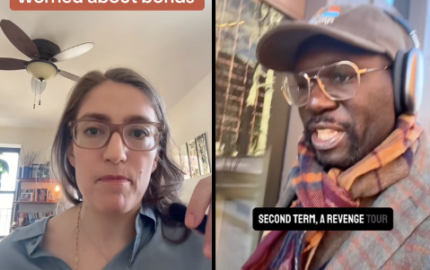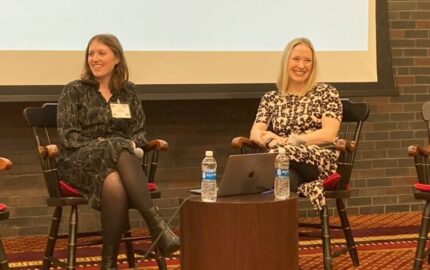 Lisa Mullins, chief anchor and senior producer for Public Radio International’s “The World,” spoke with Storyboard by phone last week about taking a narrative approach to interviews. We included some of her comments in an earlier post on “Interview as story.” While we don’t want to present this as her carefully considered interviewer’s manifesto, she said a lot of interesting things about how she interviews for story, and we thought we’d pass some of her tips along to readers.
Lisa Mullins, chief anchor and senior producer for Public Radio International’s “The World,” spoke with Storyboard by phone last week about taking a narrative approach to interviews. We included some of her comments in an earlier post on “Interview as story.” While we don’t want to present this as her carefully considered interviewer’s manifesto, she said a lot of interesting things about how she interviews for story, and we thought we’d pass some of her tips along to readers.Whatever your medium, if you interview people for your stories, there’s probably something here for you. These excerpts from our conversation have been edited for clarity and structure.
Some craft tips for pulling narrative from daily news Q-and-A’s:
I tell them ahead of time what I might want. If we’re on deadline, and the person we’re going to be talking to is what we call a kind of “normal person,” maybe part of a couple in Dublin who is talking to us about how the seismic financial cuts are affecting them personally, they may be reluctant, they may be shy, they may be reticent to reveal too much. If I say, “What I’d like to leave the audience with is an idea of what your life is like right now,” then they will start telling me the information I need in the form of a story.
Then I become the person who teases them along and directs them in terms of questions, who fleshes it out. They become much more relaxed, so they’re going to make it more of a narrative. They’re not on edge, thinking that I’m going to ask them a question they can’t answer or that’s beyond them. They know that what I want is just a personal tale. It’s much easier to elicit from somebody when you give them a heads up that it’s not a gotcha interview.
On the other hand, if it is a gotcha interview, if it’s a government representative, or the foreign minister of Finland, or a State Department official, you can still have a narrative, and you can plan for the narrative, but it’s easiest in the execution when you can get the subject disarmed enough to just have a conversation. Sometimes that means interrupting a bit. Sometimes that means saying, “Hold on, I want to ask you about that in a few minutes, but let’s get back to this other point.”
Then people will speak more naturally to you. They’re not going to talk sound bites. You have a conversation where you can take yourself out or leave yourself in, but the idea is to get them on the bicycle with you and pedaling. And then, even if there are significant challenges, or even if you take a little side route, you can easily come back, because they understand the thrust. You can intentionally move someone off to the side and then move them back in when you’re engaging them more easily.
In terms of a long or more documentary-style interview:
Again, sometimes I give people a heads up on what I want to get out of it. Usually I’ll speak to them off the top of my head, so they can get an idea of the natural cadence in my own voice as I’m talking to them. We like to have our introductions written ahead of time, something like: “OK, we’re rolling tape in three, two, one: I’m Lisa Mullins. This is ‘The World.’ In Uruguay a group of high school students has been learning a lesson in finance...”
With that kind of intro, suddenly things become arch and uncomfortable. I want to have set the tone prior to that, so that someone knows my regular conversational style, and they’ll get in sync with me as soon as I ask the first question. I’d like to keep that conversational tone going. That’s how you get the narrative; that’s how you get someone to start from the beginning, to tell you the story, and not just give you what they expect you want to know.
When they’ve practiced or repeated so much of what they have to say that they’re speaking on automatic pilot, that detracts from the interview. When I can get them speaking in terms of chronology, in terms of a thought process, in terms of watching a story unfold and then maybe bringing it back to the beginning, that’s when the audience is naturally going to listen. People have an ear for storytelling, and everybody wants to hear a good story.
I find Q-and-A’s incredibly intriguing, written Q-and-A, because they’re easy to follow. There’s a logic to them. I’d say the same thing for Q-and-A’s that you hear on the radio, even more so, I think, than on television. You get nuance, you get meaning in silence, in pauses and sighs, in tension. You can hear conflict when there’s nothing on the air.
If there’s a sense of conflict in the interview, very often listeners will listen even more carefully, and they’re surprised there might be a resolution at the end. “Gee, the person was taken aback,” or “Maybe someone was drawing the wrong conclusions.” And “Hey, at the end, it wasn’t as bad as all that.”
So, look! You were transported somewhere. There was a different end to the story from what was expected, based on not just what was said but what wasn’t said, where the silent irritation was, where the withdrawing was on both sides. I think that’s as much a part of the narrative of the story as anything.
Ideally, I would love to have listeners come into an interview and feel intrigued, maybe projecting where they think the interview might go. And then at the end not even being aware of how much time has elapsed, thinking, “Wow. Where did I just land?” That usually happens when you’ve taken them on a mini narrative journey.
Generally speaking:
I want the producer to find everything that he or she possibly can about the subject that we’re going to be talking about. I read as much as I can and have time for, but if the interview is bearing down on me, I just start a mind purge and write down questions immediately with the ones that are most obvious to me. Those are the ones our listeners will probably be most interested in. I will type out several questions of my own. I get everything in front of me, and sometimes don’t even look down again after the first question. I do like to have a solid launching point for the first question, though, and I try to figure out where I want to go.
How many angles are too many angles? When is this going to be watered down because I’m putting too many hats on this person? The job for me is to contain information and to keep it on a straight road, almost putting blinders on. You remain open to any slight turn or twist, but you have to be as disciplined as possible to know when you’re letting yourself go too far in one direction or letting the interviewee go too far, for a bunch of reasons:
One, it doesn’t serve the audience. Everything’s being diluted if you don’t have the trajectory. Two, my producer is going to kill me, because the piece is going to be cut down to 4 1/2 minutes regardless of how long we record. Also, because I want to have a story, a nugget, from that person that people will listen to.
If I’m disciplined, and they kind of know what I want, then they’re not flailing around. A lot of the fear in interviews happens when the interviewee doesn’t know if he or she is giving you want you want, and there’s a lot of meandering and uncertainty. Even the most kind of squidgy seemingly open-ended interview really has to have a certain amount of discipline around it to be successful. It’s a lot harder than doing a “What did the White House say today?” interview.
Narrative doesn’t mean arduous planning necessarily. Narrative means having your path cut out for you, but not necessarily knowing where exactly it will take you, just that you want a place to touch down. By the way, that end point may lead you to infinity – to more tension or some nonresolution. Everything doesn’t have to be tied up in a bow, but I want us to be able to land somewhere at the end.


